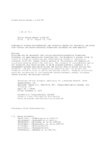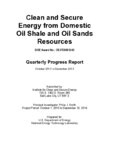TO
Filters: Collection: "ir_eua"
| Title | Date | Subject | Description | ||
|---|---|---|---|---|---|
| 76 |
 |
LETC tar sand research - North Asphalt Ridge | 1985 | LETC tar sand research; North Asphalt Ridge; tar sand; in situ recovery methods; classifying tar sand deposits; in situ recovery process; tar sand deposits | This report describes work done by the United States Department of Energy's Laramie Energy Technology Center (LETC) from 1971 through 1982 to develop technology for future recovery of U.S. tar sands. The objectives of the program are: 1. To determine the feasibility of in situ recovery methods appli... |
| 77 |
 |
Petroleum geology of the greater Red Wash Area, Uintah County, Utah | 1965-07 | oil and gas field; sandstone; petroleum geology | The Greater Red Wash area is the largest oil and gas field in the Uinta Basin. The Douglas Creek and Garden Gulch Members of the Green River Formation form a lacustrine delta in the area and yield hydrocarbons from a complex network of discrete sandstones. Each individual sandstone body forms its ow... |
| 78 |
 |
Clean and secure energy from domestic oil shale and oil sands resources: Quarterly progress report - April 2014-June 2014 | 2014 | domestic oil shale resources; domestic oil sands resources; ICSE; developing oil resources; CO2 management; utilization of oil shale and oil sands; liquid fuel production; in-situ thermal processing of oil shale | The Clean and Secure Energy from Domestic Oil Shale and Oil Sands Resources program, part of the research agenda of the Institute for Clean and Secure Energy (ICSE) at the University of Utah, is focused on engineering, scientific, and legal research surrounding the development of these resources in ... |
| 79 |
 |
Field experiment of reverse combustion oil recovery from a Utah tar sand | 1980 | field experiment; reverse combustion; oil recovery; Utah tar sand; hydrocarbon reserves | A field experiment to recover oil from tar sand by reverse combustion was conducted at Northwest Asphalt Ridge, near Vernal, Utah. This test was in a 10-foot interval of the Rim Rock sandstone member of the Mesa Verde Formation at a depth of approximately 300 feet. Ignition was accomplished November... |
| 80 |
 |
Method of recovery of bitumen from tar sand formations | 1977-01-18 | Patent; Bitumen recovery; Tar sand formation | A competent permeable communication zone connecting injection and production wells completed in a tar sand which communication zone will be rigid and will not tend to slump or heal may be developed by injecting a fluid in the injection well under such pressure so as to fracture the tar sand formatio... |
| 81 |
 |
Subtask 6.1: Engineering process models for economic impact analysis | 2011-03-10 | engineering process models; economic impact analysis; domestic heavy oil; developing domestic heavy oil/sands/shale resources | A presentation given at the Unconventional Fuels from Oil Shale and Oil Sands Project Review Meeting on March 10-11, 2011. In the project objectives, the purpose of assessment is to "Examine limiting factors to the development of domestic heavy oil, oil sands, and oil shale resources. Identify poli... |
| 82 |
 |
Unconventional fuel development in the western United States: Integrated assessment of water resources, carbon, and energy impacts and management strategies | 2009 | unconventional fuels; water resources; carbon; energy impacts; fossil fuels; oil shale; CO2 imprint; CO2 capture and sequestration. | The Western United States contains rich fossil resources including abundant supplies of oil shale that could be used to develop substantial quantities of transportation fuel, enhancing energy security in the United States. Development of these resources poses significant questions regarding water re... |
| 83 |
 |
U.S. Energy Research and Development Administration field experiment | 1976-06 | U. S. energy research and development; field experiment; reverse combustion process; oil recovery; tar sand; alternative forward process | The Laramie Energy Research Center of the U. S. Gov Research and Development Administration is equiping a small-scale field experiment to test the reverse combustion process to recover oil from tar sand. This field experiment, the first of a planned series, will extend the results of laboratory work... |
| 84 |
 |
Clean and secure energy from domestic oil shale and oil sands resources: Quarterly progress report: January 2012 to March 2012 | 2012-04 | ICSE; University of Utah; Green River Basin; CO2 capture; Oil sands; Crude oil refining; International Flame Research Foundation; IFRF; Oil shale; Pyrolysis; Thermogravimetric analysis; TGA; TEA-C burner; Uinta Basin; Flameless oxy-gas process heaters; Efficient CO2 capture; Liquid Fuel Production ... | The Clean and Secure Energy from Domestic Oil Shale and Oil Sands Resources program is part of the research agenda of the Institute for Clean and Secure Energy (ICSE) at the University of Utah. In outreach efforts, ICSE participated in a session on oil sands at the Utah Governor's Annual Energy Deve... |
| 85 |
 |
UHOP--project review meeting Wednesday March 12, 2008: Agenda | 2008-03-12 | UHOP; agenda. | |
| 86 |
 |
Lithofacies and related hydrocarbon accumulations in Tertiary strata of the western and central Uinta Basin, Utah | 1975 | lithofacies; hydrocarbon accumulations; Tertiary strata; Uinta Basin; stratigraphy | Strata of Tertiary age in the Uinta Basin were deposited in an internally drained depression. They can be divided into (1) a central core of organic-rich open lacustrine claystone and mud-supported carbonate surrounded by (2) marginal lacustrine sandstone, claystone and mud- and grain-supported carb... |
| 87 |
 |
Attachment 2 - Statement of program objectives: Clean and secure energy from domestic oil shale and oil sands resources | 2009-09-24 | ICSE; University of Utah; Energy; Oil shale; Oil sands; CO2 capture; Liquid fuel; In-situ thermal processing; NOx emissions; CO2 emissions; Flameless oxy-gas process heaters; Efficient CO2 capture; Large Eddy Simulation; LES | The University of Utah (the Recipient), via their Institute for Clean and Secure Energy (the Institute), shall pursue research to improve industry's ability to utilize the vast energy stored in domestic oil shale and oil sands resources in a manner that shall minimize environmental impact and effect... |
| 88 |
 |
Clean and secure energy from domestic oil shale and oil sands resources: Quarterly progress report: April 2010 to June 2010 | 2010-07-31 | ICSE; Oil shale; Oil sands; Oxy-fuel; CO2 capture; OXYFLAM; Uinta Basin; Utah; Parachute Creek Member; X-ray microtomography; Freen River oil; Kerogen; Thermal gravimetric analyzer experiments | The Clean and Secure Energy from Domestic Oil Shale and Oil Sands Resources program is part of the research agenda of the Institute for Clean and Secure Energy (ICSE) at the University of Utah. In this quarter, the Clean and Secure Energy program continued its efforts to enhance the dialogue between... |
| 89 |
 |
Combination solvent-noncondensible gas injection method for recovering petroleum from viscous petroleum-containing formations including tar sand deposits | 1978-08-29 | Patent; Petroleum; Tar sand deposits; Petroleum recovery; Viscous petroleum-containing formations; Gas injection; Unreactive; Combination solvent-noncondensible gas injection method; Bitumen | Petroleum may be recovered from viscous petroleum-containing formations including tar sand deposits by injecting into the formation a solvent which is liquid at formation conditions and simultaneously therewith injecting a substance which will remain totally gaseous at the pressure and temperature c... |
| 90 |
 |
Utah Heavy Oil Program - Final Scientific/Technical Report - Project Period: June 21, 2006 to October 20, 2009 | 2010-01-31 | Utah heavy oil program; heavy oil; UHOP; developing heavy oil resources; oil sands resources; oil shale resources | The Utah Heavy Oil Program (UHOP) was established in June 2006 to provide multidisciplinary research support to federal and state constituents for addressing the wide‐ranging issues surrounding the creation of an industry for unconventional oil production in the United States. Additionally, UHOP w... |
| 91 |
 |
Part 9 | |||
| 92 |
 |
Assessment of research needs for oil recovery from heavy-oil sources and tar sands | 1982-03 | The Fossil Energy Research Working Group (FERWG), at the request of J. W. Mares (Assistant Secretary for Fossil Energy) and A. W. Trivelpiece (Director, Office of Energy Research), has reviewed and evaluated the U.S. programs on oil recovery from heavy oil sources and tar sands. These studies were p... | |
| 93 |
 |
Green River oil shale potential in Utah | 1963-01 | Green River oil shale; oil shale potential; oil shale; Green River formation; oil reserves; oil shale extraction | The Green River formation of Colorado, Utah, and Wyoming contains the greatest potential reserves of oil in the world. The problem has been that of finding an economical method of extraction. The first economic study of the oil shale in Utah started in 1913 (Woodruff and Day, 1914). Since that time ... |
| 94 |
 |
Utah Science, Technology, and Research (USTAR): Turning innovations into industry | 2008-11-13 | innovation into industry; fossil energy; USTAR. | Utah Science Technology and Research (USTAR) -- A bold and far-reaching initiative supported by Utah industry and business leaders, sponsored by the Governor and the State legislature, that aims to ensure that Utah remains a leader in the Knowledge Economy! |
| 95 |
 |
Bituminous sandstone deposits Asphalt Ridge | 1966-12 | Asphalt Ridge probably is the second largest bituminous sandstone deposit in northeastern Utah's Uinta Basin. Discontinuous concentrations of bitumen occur in the Rim Rock Sandstone of the Mesaverde Group of Cretaceous age, in the overlying Uinta Formation of Eocene age and the Duchesne River Format... | |
| 96 |
 |
An echoing in-situ combustion oil recovery project in a Utah tar sand | 1982 | in-situ combustion; oil recovery project; Utah tar sand; echoing in-situ; U.S. tar sand resources; reverse combustion process; heterogeneous tar sand reservoir | U.S. tar sand resources contain an estimated 30 billion bbl (4.7 Gm3) of oil in place in about 550 occurrences in 22 states. Over 90% of the known resources are in six large deposits in Utah, each containing from 1 to 16 billion bbl (0.15 to 2.5 Gm3) of oil. 1 Four major tar sand deposits in Alberta... |
| 97 |
 |
Fischer Assay Data, Utah Geological Survey Well Number U156 | 2008 | This dataset contains the results of Fischer assay analyses obtained and published by the Utah Geological Survey for well U156. | |
| 98 |
 |
Problems facing tar sand development | 1977-07 | Interstate Oil Compact Committee Bulletin; heavy oil deposits develompment; Tar Sand Triangle | This issue of the Interstate Oil Compact Commission Committee Bulletin contains papers presented before the meetings of the Standing Committees of the Interstate Oil Compact Commission on July 11 and 12, 1977, at Nashville, Tennessee. All available papers presented before the committees at this meet... |
| 99 |
 |
Clean and secure energy from domestic oil shale and oil sands resources: Quarterly progress report - October 2013-December 2013 | 2013 | domestic fuel resources; ICSE; CO2 management; unconventional fuels; Flameless Oxy-gas Process Heaters; Efficient CO2 Capture; Production Modules for CLEARuff | The Clean and Secure Energy from Domestic Oil Shale and Oil Sands Resources program, part of the research agenda of the Institute for Clean and Secure Energy (ICSE) at the University of Utah, is focused on engineering, scientific, and legal research surrounding the development of these resources in ... |
| 100 |
 |
Clean and secure energy from domestic oil shale and oil sands resources: Quarterly progress report: October 2013 to December 2013 | 2014 | ICSE; Quarterly report; Clean and secure energy; Oil shale; Oil sands; Uinta Basin; CO2 management; AMSO; Greenhouse gas control; Shale formation; In situ; Ex situ; TEA-C | EXECUTIVE SUMMARY The Clean and Secure Energy from Domestic Oil Shale and Oil Sands Resources program, part of the research agenda of the Institute for Clean and Secure Energy (ICSE) at the University of Utah, is focused on engineering, scientific, and legal research surrounding the development of t... |
